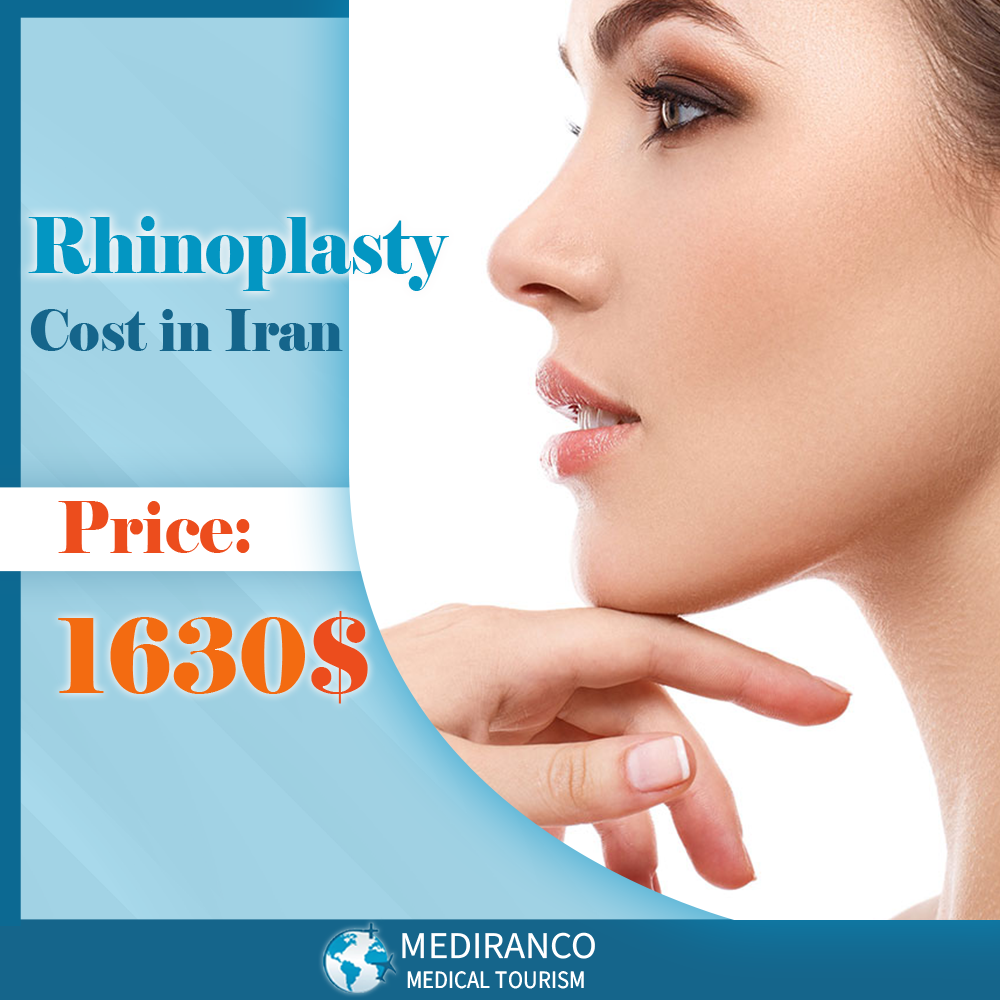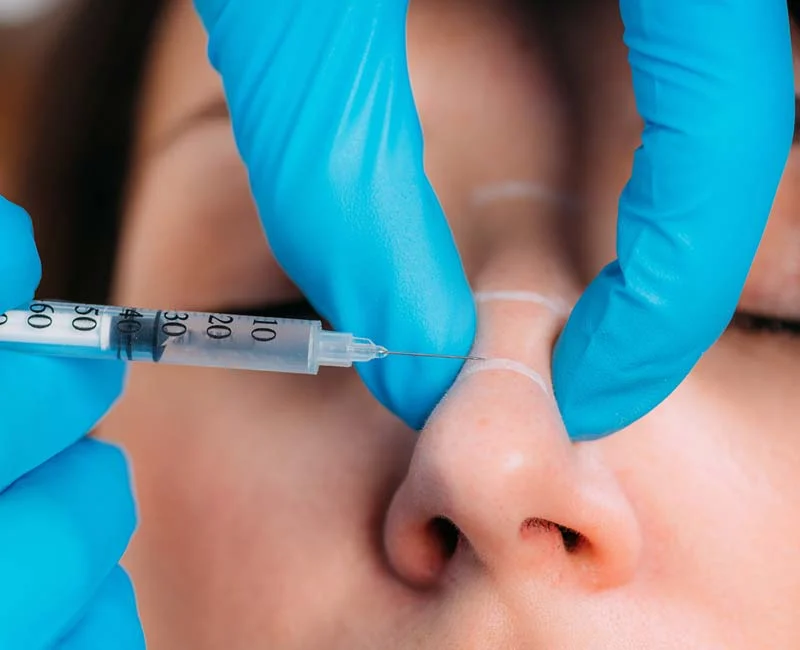Rhinoplasty or nose job, is one of the most common plastic surgery procedures. However, there is an increasing interest in less invasive and inexpensive ways to modify the nose. This is where the non-surgical rhinoplasty comes in. Nonsurgical rhinoplasty or liquid rhinoplasty is a relatively new technique that temporarily changes the shape of your nose. In this article we will discuss about this procedure and its pros and cons compared to traditional rhinoplasty.
Table of Contents
ToggleHow is nonsurgical rhinoplasty done?
The procedure involves injecting a liquid filler strategically under the surface of the skin and at the correct depth, using a needle by a medical professional to temporarily change the nose’s shape. The aim is to achieve a better definition, straightened and lifted nose, enhancing of the contours of the nose and providing more harmony and balance with your facial features.
What are the advantages of nonsurgical rhinoplasty?
The most notable benefit of nonsurgical rhinoplasty is that you can achieve your desired results without plastic surgery. Unlike surgical rhinoplasty, this treatment takes less than one hour, it’s done as an outpatient procedure and under local anesthesia, there aren’t any incisions or scarring and no downtime is necessary. Other advantage of this treatment is that you can see the results immediately after the procedure and even if you are not satisfied with the results, the changes can be reversible by injecting enzymes.
Another advantage of nonsurgical rhinoplasty is that allows you to be involved and provide feedback during the process of shaping and contouring of the nose as you will be awake, meaning you can have control over the end result.
A nonsurgical rhinoplasty can add volume to your nose, smooth out bumps, fill indentations (such as a deep nasal bridge), lower nostrils, and make your nose appear more symmetrical. It can even out a convex or concave nose. This procedure also works well if you want to lift the tip of your nose or make it more prominent.
This procedure is perfect for those who want to temporarily address issues like a small bump, a drooping nasal tip, and asymmetry.
What are the disadvantages of nonsurgical rhinoplasty?
This procedure can’t take any tissue away or make the nose smaller or narrower.
It’s not suitable for nose shapes including a nose tip that is heavily plunged or has a large bulbous. A bulbous tip is where the tip of the nose is rounded and appears too big or without a structure. For these conditions surgery is likely the best option.
It can’t correct internal issues, such as a deviated septum or a nasal functional problem.
The FDA has not approved the use of fillers in the nose.
You have to repeat the procedure frequently in order to maintain the results.
What are the side effects of nonsurgical rhinoplasty?
Side effects of the treatment may include redness, bruising and swelling at the injection site, which normally subside within 24 to 48 hours and then can be covered with makeup.
Another side effect is filler migration, which means the injectable ingredient migrates to other areas of your nose or the area under your eyes, that creates a “wavy” or “overfilled” look.
Some patients may have a hypersensitivity reaction, which can cause itching, fever, and pain.
What fillers are involved in a nonsurgical rhinoplasty?
- Bovine collagen is a naturally occurring protein found in the cartilage, bones and hides of cows. This type of collagen is very similar to what we have in our bodies and has a healthy dose of types I and III collagen, which are the major components of our skin, hair and nails.
- Silicone
- Hyaluronic acid (HA) is the most commonly used filler due to its softness and natural feel. It’s naturally found throughout the body, especially in eyes, joints and skin. It dissolves quickly and need more frequent injections but it’s also easily reversible.
Revolax, Juverderm and Restylane are the most effective and well-known dermal filler brands that are used for non-surgical nose job. - Calcium hydroxylapatite (CH) is a mineral that is naturally found in bones and teeth. Its effects last longer but it’s not easy to reverse. It may cause more discomfort following the procedure.
- Botox can also be used in some cases
Does nonsurgical rhinoplasty hurt?
You might feel a slight pinching or pressure during the procedure but before the procedure begins, you can ask your doctor to apply a topical numbing cream on your nose to minimize the pain of injecting fillers.
How to prepare for nonsurgical rhinoplasty?
Blood thinning medications such as aspirin and ibuprofen should be avoided for one week prior to your appointment to prevent bruising during and after the treatment. You should consult with your medical practitioner before stopping any medication.
If you are planning to have any major dental treatments after the treatment, please make a week interval between your appointments. This includes root canal extraction/treatment and deep filing.
You can take Arnica tablets before and after the treatment to reduce the risk of bruising
Don’t consume alcohol 2-3 days prior to your appointment to lessen the risk of bleeding and bruising.
Drink plenty of water and eat something with starch and protein before your appointment.
How long does a nonsurgical nose job last?
In most cases, nonsurgical nose jobs last about six months but depending on the individual metabolism, lifestyle and the type of dermal filler used, the results can last up to 18 months. For this reason, you need to repeat injections to maintain the appearance of the nose.
What to do after a nonsurgical rhinoplasty?
You can take some acetaminophen (Tylenol) for pain relief. It’s better to sleep with your head elevated on the first night. Avoid manipulating the nose and engaging in vigorous activity for 2–3 days after the procedure. Depending on the location of the injections, you may have to avoid wearing sunglasses for a while to avoid creating an indentation. Make a follow-up appointment in 1–2 weeks for a clinician to review results. You should also avoid strenuous activities for a week. You can use an ice pack to minimize redness and inflammation.
When should you contact your healthcare provider?
If you’ve recently had a nonsurgical nose job, contact your healthcare provider if you develop any symptoms like blurred vision, fever, allergic reaction (such as hives), redness or swelling that worsens after three days.
Is nonsurgical rhinoplasty safe?
Any procedure has its own risks. But because your nose is vascular (filled with blood vessels) and close to your eyes, nonsurgical rhinoplasty is more technical and complicated than other dermal filler procedures. That’s why it’s important to have the treatment performed by a licensed and experienced professional such as a plastic surgeon, to avoid potential complications such as:
potential complications
- Infection
- Fever
- Vascular complications
- Blurred vision or blindness
- Increasing redness or swelling
- Tissue necrosis (death)
- Vision loss
- Foreign body granuloma, which is an immune response that usually occurs with silicone injections. It can be treated with steroids or surgical removal.
- Biofilms, which are a substance that protect microbes to allow them to grow. It can be treated with antibiotics.
Can Nose Filler be done before or after surgical rhinoplasty?
If you are unsatisfied with the result of your rhinoplasty, it can be fixed by adding filler into the areas of concern. This procedure is called Non-Surgical Revision Rhinoplasty and can be done 6 to 12 months after surgical rhinoplasty.
If you have had the non-surgical nose filler and want to go under surgical rhinoplasty, you should wait until the fillers have completely dissolved before going ahead with the surgical treatment. You can speed up this process by injecting enzymes such as Hyaluronidase which can help dissolve the fillers.
The cost depends on what kind of filler you choose, the provider you choose, and how many injections you need.
How much does it cost?
The cost of nonsurgical rhinoplasty is much lower than a traditional rhinoplasty but you have to keep in mind that the results aren’t permanent and have to repeat the procedure every few months. So overall the cost of nonsurgical rhinoplasty may be even more than a traditional rhinoplasty.
In conclusion nonsurgical rhinoplasty is an excellent way to make minor changes to your nose but if you’re looking for a dramatic, permanent change to your appearance, the non-surgical nose treatment is not suitable for you. Nonsurgical rhinoplasty is also not suitable for all nose shapes and is limited to changes that make the nose bigger. Even financially it makes more sense to choose traditional rhinoplasty. Overall by doing surgical rhinoplasty you will have better results with a one time procedure.
If you are considering surgical rhinoplasty, Mediranco is one the best choices for providing you with the best possible care. If you have any unanswered questions or are still having doubt about which treatment is better for you, you can contact our support team and they will answer all your questions as soon as possible. Mediranco will also provide you consultation with the best plastic surgeons to help you chose the best treatment. By choosing Mediranco you will get the best results at the best possible price.

the cost of rhinoplasty cannot be estimated and must be determined after consultation with the doctor and surgeon. For more information about rhinoplasty in Iran cost, you can contact Mediranco health tourism company so that our experts can advise you about the surgery you want and finally know the exact cost of rhinoplasty.

